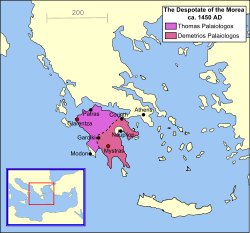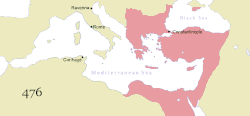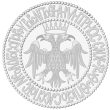This article needs additional citations for verification. (March 2009) |
Despotate of the Morea Δεσποτᾶτον τοῦ Μορέως | |||||||||
|---|---|---|---|---|---|---|---|---|---|
| 1349–1460 | |||||||||
Seal of Demetrios Palaiologos as Despot of the Morea
| |||||||||
 The Despotate of the Morea in 1450, divided between the two brothers, Thomas and Demetrios Palaiologos | |||||||||
| Status | Semi-autonomous appanage of the Byzantine Empire | ||||||||
| Capital | Mystras (main capital, 1349–1460) | ||||||||
| Common languages | Medieval Greek | ||||||||
| Religion | Eastern Orthodox Church[1] | ||||||||
| Government | Feudal monarchy | ||||||||
| Despot of Morea | |||||||||
• 1349–1380 | Manuel Kantakouzenos | ||||||||
• 1449–1460 | Thomas Palaiologos and Demetrios Palaiologos | ||||||||
| Historical era | Late Medieval | ||||||||
• Established | 1349 | ||||||||
| 1453–1454 | |||||||||
| 29 May 1460 | |||||||||
| |||||||||
| Today part of | Greece | ||||||||
| History of the Byzantine Empire |
|---|
 |
| Preceding |
| Early period (330–717) |
| Middle period (717–1204) |
| Late period (1204–1453) |
| Timeline |
| By topic |
|
|
The Despotate of the Morea (Greek: Δεσποτᾶτον τοῦ Μορέως) or Despotate of Mystras (Greek: Δεσποτᾶτον τοῦ Μυστρᾶ) was a province of the Byzantine Empire which existed between the mid-14th and mid-15th centuries. Its territory varied in size during its existence but eventually grew to include almost all the southern Greek peninsula now known as the Peloponnese, which was known as the Morea during the medieval and early modern periods. The territory was usually ruled by one or more sons of the current Byzantine emperor, who were given the title of despotes (in this context it should not be confused with despotism). Its capital was the fortified city of Mystras, near ancient Sparta, which became an important centre of the Palaiologan Renaissance.
- ^ Melton, J. Gordon (2014). Faiths Across Time: 5,000 Years of Religious History [4 Volumes]: 5,000 Years of Religious History. ABC-CLIO. p. 800. ISBN 9781610690263.

